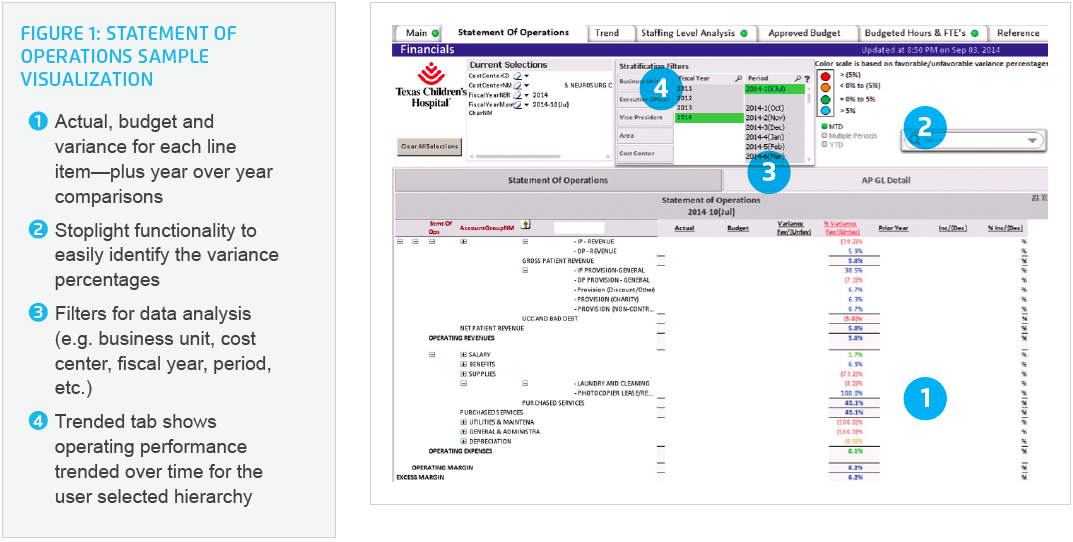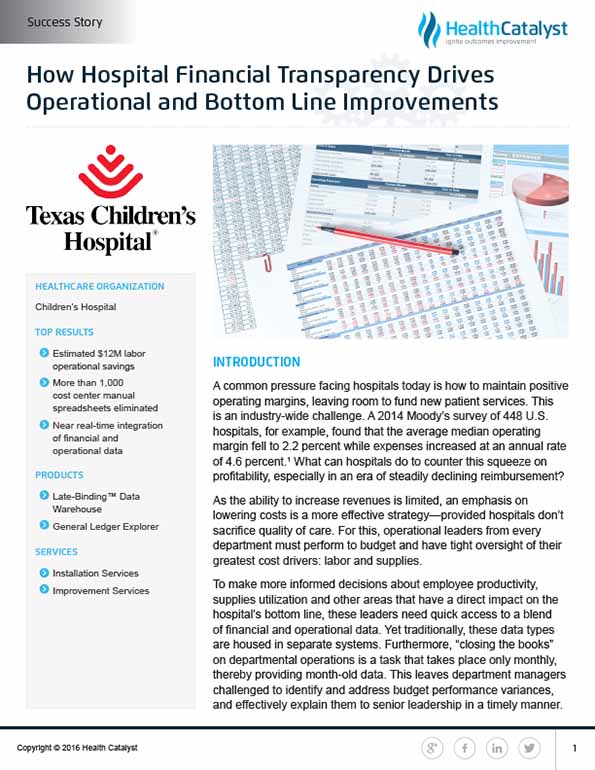Texas Children's Hospital has integrated financial and operational data in near real-time, enhancing leadership's visibility into decision-making impact on profitability. This approach allows for informed decision-making, proactive issue management, and consistent budget monitoring, enabling leaders to easily analyze cost center discrepancies through the general ledger.
A common pressure facing hospitals today is how to maintain positive operating margins, leaving room to fund new patient services. This is an industry-wide challenge. A 2014 Moody’s survey of 448 U.S. hospitals, for example, found that the average median operating margin fell to 2.2 percent while expenses increased at an annual rate of 4.6 percent.1 What can hospitals do to counter this squeeze on profitability, especially in an era of steadily declining reimbursement?
As the ability to increase revenues is limited, an emphasis on lowering costs is a more effective strategy—provided hospitals don’t sacrifice quality of care. For this, operational leaders from every department must perform to budget and have tight oversight of their greatest cost drivers: labor and supplies.
To make more informed decisions about employee productivity, supplies utilization, and other areas that have a direct impact on the hospital’s bottom line, these leaders need quick access to a blend of financial and operational data. Yet traditionally, these data types are housed in separate systems. Furthermore, “closing the books” on departmental operations is a task that takes place only monthly, thereby providing month-old data. This leaves department managers challenged to identify and address budget performance variances, and effectively explain them to senior leadership in a timely manner.
Texas Children’s Hospital is taking a more holistic approach to performance improvement using integrated operational and financial data, accessed from a single analytics solution. In the process, Texas Children’s has freed millions that can be used to provide additional services.
Like many healthcare providers, Texas Children’s was facing expenses much higher than original budget targets. When a $50 million shortfall in profitability was forecasted, Texas Children’s decided to close the gap, and identified upwards of $60 million in performance improvement opportunities. Accordingly, Texas Children’s launched a sweeping improvement initiative called “Delivering on the Vision.” There are a number of components to the strategy, including one that is the central focus of this success story: implementing greater accountability among leaders, providers, and frontline managers for their clinical and operating performance.
As this accountability could not be realized without greater visibility into potential cost savings opportunities, these key professionals needed integrated and timely data about multiple cost centers and sub-units. At the time, however, Texas Children’s finances were spread across approximately 1,000 cost centers, each with its own individual financial statement spreadsheet. Creating a financial statement for the entire hospital, or even by department or sub-unit, took so much time it happened only monthly. Certain useful views of information—such as for individual manager/administrator, physical location, business unit or area—were too cumbersome to be produced on a regular basis at all. Meanwhile, analyzing areas made up of multiple cost centers, like acute care or the newborn center, required linking and adding together dozens of individual spreadsheets. Despite such exacting procedures, operational and financial leaders were still constrained in their ability to perform high level, roll-up analysis or drill down into important details that would explain variances.
Because books were closed once a month, leaders had to rely on month-old data, plus the additional week it took to compile reports. This essentially made it impossible to clearly identify and understand variances in performance to budget in a timely way and to quickly make the right corrections. In one example, Texas Children’s knew that 77 percent of its patient care units weren’t flexing staff efficiently to census. But the hospital could not determine why without laboriously tracking down journal entry and accounts payable details from separate systems and cost centers.
For the accounting team, closing the books and producing reports was a time-intensive endeavor that involved the creation of extensive data tables for each of the 1,000 cost centers and heavy coordination with owners of other data systems. Each month, it took a full day’s worth of undivided attention from three individuals to create financial statements for the various operating units and then another day to create executive-level reports. Even so, cost center managers with responsibility for multiple departments still had to spend up to two weeks per month to learn and develop explanations for variances. Oftentimes, when they couldn’t arrive at the level of detail necessary to achieve this—for example, to understand why expenditures in supplies were going up—they would need to reach out to the accounting department, which generally took one to two weeks to deliver the answers.
In order to realize bottom line improvements, Texas Children’s leveraged its existing Late-Binding™ Enterprise Data Warehouse (EDW) platform from Health Catalyst. Data from sources like the EHR, financial systems and operational systems were integrated into the data warehouse to create an enterprise-wide, integrated single source of truth that could help hospital and department leaders track financial and operational performance, and most importantly, accurately inform their decisions.
The financial and operational data enabling these new capabilities is now accessible through a single application, General Ledger Explorer, also offered by Health Catalyst. As the application runs on the EDW, data stays refreshed in near real-time, helping users conduct reliable and timely trend and performance variance analysis. With the tedious task of consulting multiple systems and departments now gone, problematic issues are identified and addressed much sooner.
The application features standard monthly financial statement reporting with actionable visualizations, such as actual versus budget (Figure 1). Determining which areas are creating budgetvariances, right down to the budget line item, is now a simple matter of logging into the application for direct access to detailed APGL (accounts payable generation ledger) operational information. A “stoplight” feature lets users quickly see if expenses are exceeding, meeting or are under budget, with favorable variances indicated in blue and negative variances in red. Now leadership and operational managers can easily identify areas of concern and readily drill down into the data to identify the cause of a variance.

Put plainly, this feature goes a long way in increasing accountability. Performance-driven managers obviously don’t want to be known for their “red lights,” although “blue lights” can also indicate trouble—such as a budget that exceeded needs or dollars not spent that should have been. The beauty is that users can now discover the true reason for variances from the same application that identifies them. Information is readily available to leadership and decision makers at either a summary or granular level, a significant improvement from the previous environment.
With the analytics application, operating performance can be trended over time for each hierarchy, making it easy to spot trends and determine if performance is meeting expectations. Seasonal variation compared to years past, and how operations are altered during those time periods, can also be viewed. This improves the ability to create more accurate budget forecasts.
Operational data related to Texas Children’s largest expense item—salary and benefits—is directly integrated into the application with its own staffing level analysis tab for rapid and easy analysis (Figure 2). This view of data allows operational leaders to manage labor more effectively. Once the user identifies a variance in the staffing line item on the Statement of Operations (Figure 1), they are able to use the staffing level analysis tab to drill into budgeted versus actual FTEs and understand the reason behind the variance (e.g., the patient volume may be higher than expected, resulting in greater staffing needs).

Texas Children’s has greatly surpassed original targets in improvement performance opportunities. By equipping leaders with ready access to integrated, near real-time financial and operational information, the hospital has improved quality, increased system wide efficiency and eliminated workflow waste—all while lowering costs. To date, “Delivering on the Vision” has realized $74 million in performance improvements, with new financial and operating analytics driving a significant portion of this number. An estimated $12 million of these savings have been attributed to improved labor performance.
Increased financial transparency. “The data doesn’t lie”—which means all operational leaders, now equipped with the good information, can better understand their performance and assume greater accountability for meeting their targets. With this improved ability to make quicker operational decisions, along with thoughtful discussion among financial and department leaders, other improvements have followed. Leaders can now quickly understand and address variances and more consistently manage to budget, all of which positively impacts the bottom line. Operational leaders are also now held to a consistent standard that they can understand and effectively use.
Improved labor productivity. General Ledger Explorer offers a clear window into budget availability for staffing, which in turn has helped departments make more efficient use of staff hours while optimizing patient care. In a clear demonstration of this new improvement, salary and benefit expense growth has been kept below net patient service revenue growth, a strong indicator of efficient staffing.
Increased accuracy in monthly financial statements. Mistakes can now be recognized and corrected during the preliminary phase of the financial statement cycle. With mistakes and their corrections taking place in the same month, an important best practice in accounting, each month’s financial reports are more accurate with a reduced need to make fixes in subsequent months.
Significant time savings have been realized by the accounting team and cost center managers. The previous two to three-day effort each month to produce reports based on aged data has been eliminated, so has the need to gather and merge financial data from 1,000 cost center spreadsheets. Now cost managers with multiple departments can quickly roll up their cost centers’ respective budget pictures—which previously took up to two weeks and relied on the accounting department for answers.
Time is now spent on understanding all or nearly all variances instead of only having time to focus on the major ones. This ability is important, as seemingly minor variances can add up to big challenges down the road. With a new insight into what’s driving all variances, managers can quickly determine the cause of each one. In just one example, Texas Children’s discovered favorable variances in radiology were due to problems with getting orders pushed through the supply chain group—a situation the hospital swiftly corrected.
With so many new efficiencies, cost managers also have more free time to perform additional strategic analysis, such as whether adding services to benefit patient care can be incorporated into the budget.
“It was difficult to expect our leadership to manage their budgets close to target when the data they relied on was a month delayed. Now leadership can make real-time actionable decisions that address problems when they arise.”
– Jennifer Wilson, Assistant Controller
Needless to say, Texas Children’s plans to continue its use of robust analytics. User feedback is driving current endeavors to further enhance features within the General Ledger Explorer application, including additional summary views and financial ratio data. Texas Children’s also plans to deploy the Revenue Cycle Explorer application in the near future to enable near real-time revenue cycle management for all revenue cycle metrics in a single and flexible application. This will assist with catching and addressing much earlier the issues that prevent claims from being paid.
Here again, Texas Children’s will have new abilities to quickly identify trends and root causes of variances—in this case in denials management, accounts receivable, charge and cash trends, write offs, and gross and net collection rates—to avoid lost revenue and the substantial rework typically required of revenue cycle teams. Paired with Texas Children’s newfound ability to identify budget performance variances and meet budget targets, the hospital’s profit margins will be maintained.


